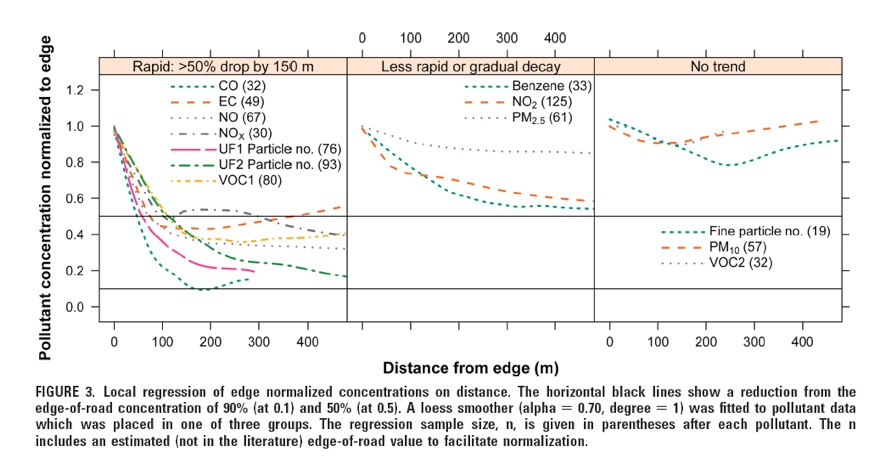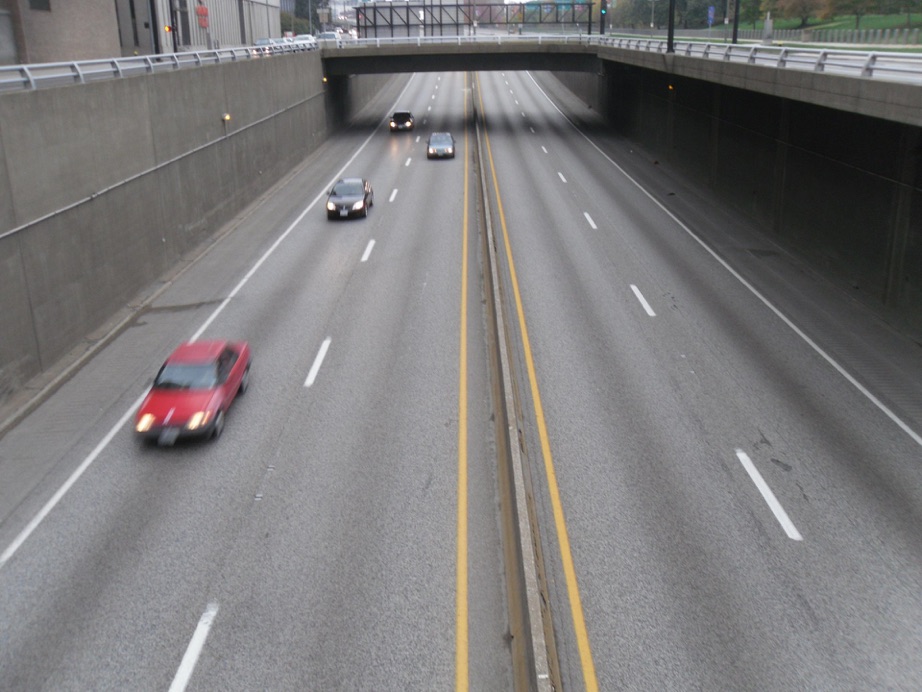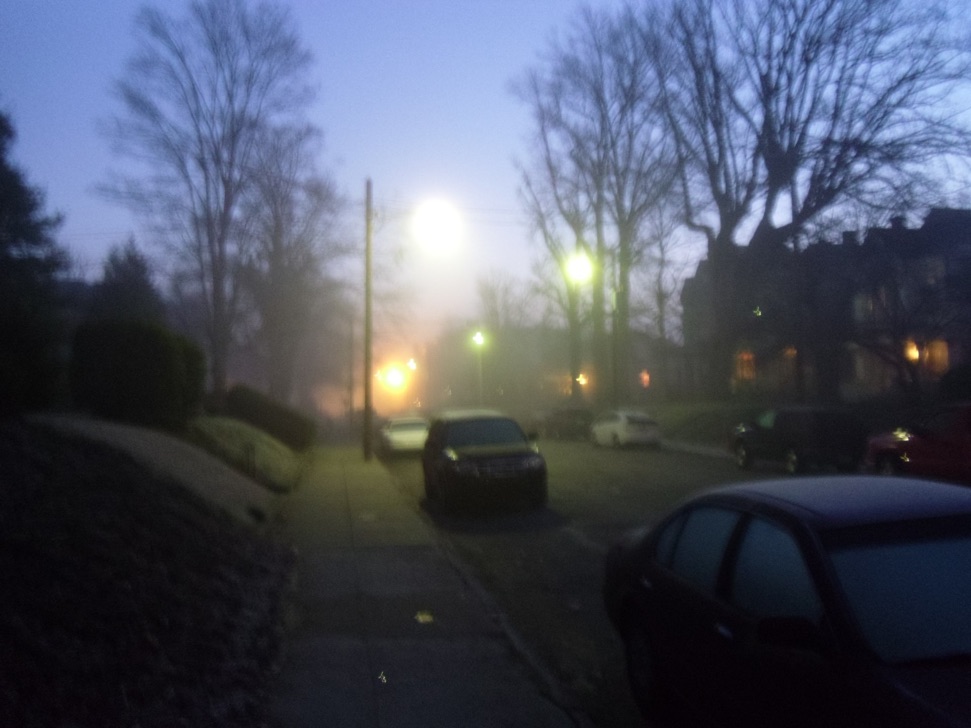
HEALTH EFFECTS OF UFP
Murray A. Mittleman, Annette Peters, David Siscovick, Sidney C. Smith, Jr, Laurie Bhatnagar, Ana V. Diez-Roux, Fernando Holguin, Yuling Hong, Russell V. Luepker, Robert D. Brook, Sanjay Rajagopalan, C. Arden Pope III, Jeffrey R. Brook, Aruni
Particulate Matter Air Pollution and Cardiovascular Disease : An Update to the Scientific Statement From the American Heart Association
free full text at:
<http://circ.ahajournals.org/content/121/21/2331.full>
Several new studies have also demonstrated that residing in locations with higher long-term average PM levels elevates the risk for cardiovascular morbidity and mortality. Some recent evidence also implicates other size fractions, such as ultrafine particles (UFPs) <0.1 μm, gaseous co-pollutants (eg, ozone and nitrogen oxides [NOx]), and specific sources of pollution (eg, traffic).
In addition, there have been many insights into the mechanisms whereby PM could prove capable of promoting CVDs (cardiovascular diseases).
Emily Cozzi, Surovi Hazarika, Howard W. Stallings, III, Wayne E. Cascio, Robert B. Devlin, Robert M. Lust, Christopher J. Wingard, and Michael R. Van Scott,
Ultrafine particulate matter exposure augments ischemia-reperfusion injury in mice,
American Journal of Physiology-Heart and Circulatory Physiology, 291: H894–H903, 2006.
Free download the full text article:
<http://ajpheart.physiology.org/content/291/2/H894.full>
THE WORLD HEALTH ORGANIZATION (WHO) recently reported that over 800,000 deaths worldwide per year can be attributed to particulate matter (PM) air pollution (65). Recent epidemiological studies have linked short-term and long-term PM exposure to increased mortality (13, 50). Short-term increases in PM exposure elevate the incidence of myocardial infarction, cardiac arrest, cardiac arrhythmia, and heart failure (12, 43, 63, 66). An analysis by Pope et al. (44) indicated that with every 10 µg/m3 increase in atmospheric fine PM, cardiopulmonary mortality increased by 6%. For a similar increase in atmospheric PM, it has been shown that there is a 2.1% increase in the number of deaths related to ischemic heart disease (51). Taken together, these current studies provide compelling evidence linking PM to adverse cardiovascular effects.
Ning Li, Constantinos Sioutas, Arthur Cho, Debra Schmitz, Chandan Misra, Joan Sempf, Meiying Wang, Terry Oberley, John Froines, and Andre Nel1,
Ultrafine Particulate Pollutants Induce Oxidative Stress and Mitochondrial Damage
Environmental Health Perspectives • Volume 111 No 4 April 2003
We demonstrate that UFPs are more potent than fine (< 2.5 μm) or coarse (2.5–10 μm) particles toward inducing oxidative stress. This effect may be explained by adsorbed chemicalsn(organics and metals) capable of generating ROS and the ability of UFPs to localize in
mitochondria.
How exactly UFPs gain access to and induce mitochondrial damage is unknown.
Our data show that UFPs are more potent than PM2.5 and PM10 that contribute the majority of mass in the HO-1 and DTT assays. It may be necessary to consider standards based on particle number instead of mass if further studies confirm the differential toxicity of UFPs.
See microscopic photos of ultrafine particulates
http://www.upstate.edu/pathenvi/studies/case5.htm
Deadly London fog
http://www.upstate.edu/pathenvi/studies/case4.htm
During the catastrophic PM exposure episode in London in December 1952, some 4,000 excess deaths occurred at the height of the event. The extreme mortality during that episode and the preservation of archival autopsy tissues allow us the unique opportunity to report on the form and composition of December 1952 London PM in situ in tissues from persons known to have died from the smog exposure. Because absolute increases in mortality with current levels of PM in Western Europe and North America are low, analogous tissues are unlikely to be contemporaneously available.
Electron microscopic analyses revealed the dominance of retained ultrafine soot and a surfeit of other particle types. A variety of metal-bearing particle types were found in all compartments, but Pb, Zn, and SnZn types appeared the least biopersistent. The figure (right) consists of a BSE image (a) of macrophages containing innumerable fine PM, and an inset (b) of a high resolution SEM Secondary Electron image showing aggregates of Ultrafine PM. These carbonaceous aggregates of Ultrafine PM may have originated from Diesel engines as well as coal burning activities. Magnification bar marker in a = 1 µm, in b = 500 nm. See also a comparison of a TEM image of these Ultrafine PM (UFPM) soot particles in the lungs with high resolution images of contemporary ambient UFPM from Syracuse, NY.
Neurotoxicology. 2011 Oct 25.
Gillespie P, Tajuba J, Lippmann M, Chen LC, Veronesi B.
Department of Environmental Medicine, New York University School of Medicine, Tuxedo, New York, United States.
Particulate matter neurotoxicity in culture is size-dependent.
Exposure to particulate matter (PM) air pollution produces inflammatory damage to the cardiopulmonary system. This toxicity appears to be inversely related to the size of the PM particles, with the ultrafine particle being more inflammatory than larger sizes. Exposure to PM has more recently been associated with neurotoxicity.
http://www.ncbi.nlm.nih.gov/pubmed?term=ultrafine%20particulate
Burden of disease associated with urban outdoor air pollution for 2008
For 2008, the number of premature deaths attributable to urban outdoor air pollution is estimated to amount to 1.34 million worldwide. Of these, 1.09 million deaths could be avoided if the mean annual Air Quality Guideline values of PM10=20μg/m3 and PM2.5=10 μg/m3 were implemented.
The number of total deaths attributable to outdoor air pollution presents an increase of 16% as compared to the previous figure of 1.15 million deaths for the year 2004. This increase is linked to recent increases in both air pollution concentrations and the total population affected as cities grow.
http://www.who.int/phe/health_topics/outdoorair/databases/burden_disease/en/index.html

Ultrafine air particulate -
more toxic to human health
. . . you’re driving in it.
Before 2004, the EPA had become aware of developing scientific research that pointed to the conclusion that ultrafine particulate matter (UFP), a class of invisible particles smaller than 2.5 microns, are more harmful to human health. Smaller particles have the ability to penetrate into the depths of the lungs and enter the blood stream and penetrate tissue organelles.
EPA also learned that ultrafine particles are heavily concentrated in traffic corridors, including very high concentrations in freeways with more ultrafine particles concentrated with higher diesel truck numbers on the road.
In 2004 the EPA administered grants to several researchers to monitor fine particulate levels near Los Angeles freeways I-405 and I-702.
Go immediately to the EPA website by clicking this link:
From 2004 to 2006 the findings of the ultrafine particulate research came in and confirmed that mobile sources--cars and trucks-- were major sources of UFP and that high concentrations surrounded traffic corridors that were not detected farther away from the highway by regional air monitoring that used gravimetric analysis to get the weight of 2.5 micron diameter particles in a cubic meter of air. Numerous studies showed that the more toxic air pollution comes from hundreds of thousands of smaller ultrafine particles about 100 nano meters in diameter that are emitted by motor vehicle combustion.
Since 2006, more research has conformed and expanded the knowledge of the toxicity and acute health impacts of exposure to high concentrations of ultrafine particulate.
The research shows we are swimming in varying concentrations of ultrafine particulates and they are taking a great health toll.
Further, EPA has dragged its feet and still does not require air pollution control agencies to identify concentrated areas of toxic ultrafine particulate that would point right at the major highways we spend hours driving on everyday. That diesel truck up ahead stinking up the road really is bad for your health.
Karner, A.A., Eisinger, D.S., and Niemeier, D.A.,
Near Roadway Air Quality: Sythesizing the Findings from Real World Data,
Environmental Science & Technology, Vol. 44, 5334-5344 (2010).
5338
The curves indicate (ignoring ozone) that concentrations of certain pollutants are elevated near roadways and decrease as the distance increases, while other pollutants show no roadway influence. These background normalized results suggest that a range of approximately 160-400 m is sufficient to reach background concentrations for the majority of pollutants.
Figure 3 (above) shows CO, benzene, EC, NO, NOX, NO2, PM2.5, and UF1 particle number, UF2 particle number, and VOC1 all decreased as distance from road increased. PM10, fine particle number, and VOC2 showed ambiguous or little to no trend with distance.
This article and numerous others show that regional level PM 2.5 data misrepresents population exposure and health risks caused by chronic exposure to near highway levels of pollutants. The FHWA gives a false
‘green light’ by using regional design standards to support its particulate conclusions.
Attainment of the standard (CAA Section 107(d)(3)(E)(i)). There are two components involved in making this demonstration. The first component relies on ambient air quality data. The data that are used to demonstrate attainment should be the product of ambient monitoring that is representative of the area of highest concentration. The data should be collected and quality-assured in accordance with 40 CFR 58 and recorded in the Air Quality System (AQS) in order for it to be available to the public for review.
Prashant, K., Gurjar, B., Nagpure, A., and Harrison, R., Preliminary Estimates of Nanoparticle Number Emissions from Road Vehicles in Megacity Delhi and Associated Health Impacts, Environmental Science & Technology, Vol. 45, 5514-5521 (2011).
Exposure to high total number particle, ToN concentrations may aggravate existing pulmonary and cardiovascular diseases due to efficient alveolar deposition of tiny particles and their potential to enter the pulmonary vascular space. Fresh vehicular exhaust contains many nanosized particles that take a few seconds of traveling time to reach to the roadside where people living, walking, or traveling by motor vehicles, bicycles and 2Ws are exposed. Concentration levels of exposure can vary up to 2 orders of magnitude or more depending on the exposed location.
For instance, concentration levels for exposure can be to ∼106 cm 3 while traveling in car in urban or tunnel routes,41 ∼105 cm 3 during cycling, walking or traveling in buses in heavily trafficked area, and ∼104 cm 3 in typical street canyon conditions. Our estimated roadside concentrations in 2005 were 6.95(4.43-16.08)X 105 cm 3; these are about 6-10 times larger than those measured by Kaur et al. at a heavily trafficked route in London during their exposure assessment study for the people walking (0.68 X 105 cm3), cycling (0.94 X 105 cm3), traveling in buses (1.01 X 105 cm 3), cars (0.99 X 105 cm 3) and taxis (0.88 X 105 cm 3). For Delhi inhabitants, current exposure to ambient and road side concentrations are of the order of ∼104 and ∼105 cm 3, respectively (Table 3).
We calculated mortality estimates for 2005 levels for comparison with other air pollutants in Delhi as 7943 (i.e., 473 mortality per million people) based on corrected ambient ToN concentrations in 2005. Normalization of the above mortality figures provides an approximately 0.69 and 48 times relative mortality impact by vehicle-derived nanoparticles in Delhi than those from TSP and NO2 exposure from all sources, respectively. These figures clearly indicate that exposure to nanoparticles is a major contributor to air pollution-related deaths in Delhi.
Zhu, Y.,Hinds, W.,Kim, S. ,Shen, S., and Sioutas, C.,
Study of ultrafine particles near a major highway with heavy-duty diesel traffic,
Atmospheric Environment, Vol. 36, 4323-4335 (2002).
4324
Recent toxicological studies have concluded that ultrafine particles (diameter < 100 nm) are more toxic than larger particles with the same chemical composition and at the same mass concentration (Ferin et aI., 1990; Oberdorster, 1996, 2001; Donaldson et aI., 1998, 2001; Churg et aI., 1999; Brown et aI., 2000). Currently, however, only the mass concentration of PM < 10 l-tm in aerodynamic diameter (PM10) and <2.5l-tm (PM2.s) are regulated. Information about ultrafine particles is usually not available. In fact, even though ultrafine particles represent over 80% of particles in terms of number concentration in an urban environment (Morawska et a!., 1998a, b), the less numerous but much heavier particles of the accumulation (0.1-2l-tm) and coarse (2.5-10 l-tm) modes dominate mass concentration measurements.
Emission inventories suggest that motor vehicles are the primary direct emission sources of fine and ultrafine particles to the atmosphere in urban areas (Schauer et al., 1996; Shi et al., 1999; Hitchins et al., 2000).
Hu, S., S. Fruin, et al. (2009). "A wide area of air pollutant impact downwind of a freeway during pre-sunrise hours." Atmospheric Environment, vol. 43(16): 2541-2549.
“In this study, real-time air pollutant concentrations were measured along a 3600 m transect normal to an elevated freeway 1–2 h before sunrise using an electric vehicle mobile platform equipped with fast-response instruments. In winter pre-sunrise hours, the peak ultrafine particle (UFP) concentration (∼95 000 cm−3) occurred immediately downwind of the freeway. However, downwind UFP concentrations as high as ∼40 000 cm−3 extended at least 1200 m from the freeway, and did not reach background levels (∼15 000 cm−3) until a distance of about 2600 m. UFP concentrations were also elevated over background levels up to 600 m upwind of the freeway. Other pollutants, such as NO and particle-bound polycyclic aromatic hydrocarbons, exhibited similar long-distance downwind concentration gradients.”
A highway canyon with high walls has higher
concentrations of air particulates
